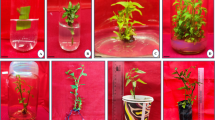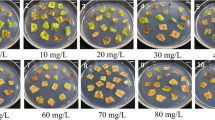Abstract
Lack of a rapid and robust in vitro regeneration protocol for Tossa jute (Corchorus olitorius L.) hinders the genetic transformation of jute crops for different agronomic traits of interest. The current study was conducted to develop a rapid, efficient, and reproducibleregeneration protocol for recalcitrant Tossa jute. The potential of auxins (IAA, IBA) and cytokinin (BAP) for the induction of callus, regeneration of shoot and formation of root from the cotyledon with attached petiole of cultivar O-9897 on MS was tested accordingly. Approximately, total 96 calli (out of 100 explants) were induced within 32 days on MS media harboring 2.5 mg/L BAP + 0.5 mg/L IAA. Within 5 weeks, about 95 calli regenerated total 99 shoots (86.6%) after 8–10 days of culture. Rooting of 52 regenerants (52.5%) was initiated on half-strength MS media supplemented with 1.0 mg/L IBA within 10 days. After acclimatization, a total of 52 rooted plantlets were transferred to the soil pot and 45 (86.53%) plantlets were survived and turned to normal plants without somaclonal variations. It is the first investigation analyzing foliar micro-morphological characters like stomata, trichomes, and vein patterning of leaves from in-vitro grown progeny and acclimatized plants that assess the developmental adaptation of micropropagated plantlets for survival under field conditions. The findings demonstrate morphological homogeneity between micropropagated plants regenerated from cotyledon explants with attached petioles and the mother plants. This is the pioneering report on foliar micromorphological analysis at subsequent micropropagation stages, confirming the phenotypic fidelity of regenerants.
Key message
In vitro regeneration of Corchorus olitorius L. is quite difficult and even nearly impossible that hinders the genetic transformation of jute crops. The current research wills unravel this difficult job into possibility.



Similar content being viewed by others
Data availability
The data that support the findings of this study are available upon request from the corresponding author.
References
Abbas AM, Jones JK, Caligari PDS (1997) Clonal propagation by in vitro culture of Corchorus (jute). Plant Cell Tissue Organ Cult 47:231–238. https://doi.org/10.1007/BF02318977
Ahmar S, Gill RA, Jung KH, Faheem A, Qasim MU, Mubeen M, Zhou W (2020) Conventional and molecular techniques from simple breeding to speed breeding in crop plants: recent advances and future outlook. Int J Mol Sci 21:2590
Anand A, Subramanian M, Kar D (2023) Breeding techniques to dispense higher genetic gains. Front Plant Sci 13:1076094. https://doi.org/10.3389/fpls.2022.1076094
Arve LE, Kruse OMO, Tanino KK, Olsen JE, Futsæther C, Torre S (2015) Growth in continuous high air humidity increases the expression of CYP707A-genes and inhibits stomatal closure. EEB 115:11–19
Bairu MW, Aremu AO, Van Staden J (2011) Somaclonal variation in plants: causes and detection methods. Plant Growth Regul 63:147–173
Bari FS (2006) Effect of NaCl and Surfactant on plant regeneration from the cotyledon of C. Capsularis and C. olitorius. Doctoral dissertation, Dept. of Biotechnol, Bangladesh Agricultural University, Mymensingh. 85–86
Baskaran P, Van Staden J (2013) Rapid in vitro micropropagation of Agapanthus praecox. S Afr J Bot 86:46–50. https://doi.org/10.1016/j.sajb.2013.01.008
Begum H (2006) Influence of different factors on plant regeneration system of Jute species (Doctoral Thesis), Department of Genetics and plant breeding, Shere-E-Bangla Agricultural University, Dhaka, Bangladesh
Begum R F Zakrzewski, Menzel B Weber, SS Alam and T Schmidt (2013) Comparative molecular cytogenetic analyses of a major tandemly repeated DNA family and retrotransposon sequences in cultivated jute Corchorus species (Malvaceae). Ann. Bot. 112(1):123–34
Bhojwan SS, Dantu PK, Bhojwani SS, Dantu PK (2013) Tissue and cell culture. Plant tissue culture: an introductory text, 39–50
Biswas A, Dey S, Huang S, Deng Y, Birhanie ZM, Zhang J, Akhter D, Liu L, Li D (2022) A comprehensive review of C. Capsularis and C. Olitorius: a source of nutrition, essential phytoconstituents and pharmacological activities. Antioxid 11(7):1358
Callaway RM, Pennings SC and Richards CL (2003) phenotypic plasticity and interactions among plants. Ecology, 84(5):1115–1128
Dönmez D, Erol MH, Biçen B, Şimşek Ö, Kaçar YA (2022) The effects of different strength of MS Media on in Vitro Propagation and Rooting of Spathiphyllum. Anadolu Tarım Bilimleri Dergisi 37:583–592
Ghosh PK, Chatterjee A (2009) Regeneration of plants from hypocotyl derived callus tissue of jute (Corchorus olitorius L. var. JRO-632). J. crop weed 5:78– 9. https://doi.org/10.3329/ptcb.v17i1.1116
Hazarika BN (2003) Acclimatization of tissue cultured plants. Curr. Sci. 85:1705–1712
Hoque M, Nasiruddin KM, Haque GK, Biswas GC (2010) In vitro regeneration performance of Corchorus olitorius. JBAU 8 (1)
Hossain, M. B., S. Haque, and H. Khan (2002) DNA fingerprinting of jute germplasm by RAPD. J Biochem Mol Biol 35(4):414–19
Huda KM, Bhuiyan MS, Kabir MH, Jamal Uddin AF, Khatun A (2007) In vitro plant regeneration protocol of Tossa jute (Corchorus olitorius). Intl J Integrat Biol 1:96–101
Islam AS, Jahan B, Chowdhury MK (1981) Attempt to produce polyhaploids from a spontaneous amphidiploid of the jute hybrid, Corchorus x C. Depressus. Bangladesh J Bot 10:63–68
Islam MS, Kamrul Huda KM, Mahmud F, Akhter Banu S, Wang MH (2009) Regeneration and Genetic Transformation of Tossa Jute (‘Corchorus olitorius L’). Aust J Crop Sci 3:287–293
Johansen DA (1940) Plant Microtechnique Plant microtechnique. First Ed
Khatun A (1993) The genetic manipulation of jute (Corchorus) species. Ph.D. Thesis, Department of Life Sciences, University of Nottingham.UK
Khatun A (2001) Varietal improvement of jute through Agrobacterium mediated transformation. Final report. Contract Research Project. Bangladesh Agricultural Res Council 4–17
Kouider M, Korban SS, Skirvin RM, Chu MC (1984) Influence of embryonic dominance and polarity on adventitious shoot formation from apple cotyledons in vitro. J Am Soc Hortic Sci 109:381–385. https://doi.org/10.21273/JASHS.109.3.381
Kuznetsova OI, Ash OA, Gostimsky SA (2006) The effect of the duration of callus culture on the accumulation of genetic alterations in pea Pisum sativum L. Russ J Genet 42:555–562
Majumder S, Sarkar C, Saha P, Gotyal BS, Satpathy S, Datta K, Datta SK (2018) Bt jute expressing fused δ-endotoxin Cry1Ab/Ac for resistance to Lepidopteran pests. Front Plant Sci 8:2188. https://doi.org/10.3389/fpls.2017.02188
Manokari M (2021) Why is MS half strength used during rooting? Retrieved from: https://www.researchgate.net/post/Why_is_MS_half_strength_used_during_rooting/619fafd6adec1e498619cfd9/citation/download
Mondal R, Meena K, Mandal AB (2022) Direct somatic embryogenesis in Commercial varieties of Corchorus L.: morphological, Histo-chemical, and ultrastructural aspects. J Nat Fibers 19:3954–3963. https://doi.org/10.1080/15440478.2020.1848739
Naher Z, Khatun A, Mahbub S, Alim MA, Siddique AB (2003) Influence of genotypes on plant regeneration from cotyledons of Corchorus capsularis L. Biotechnology (Pakistan). Biotechnol 2:44–51. https://doi.org/10.3923/biotech.2003.44.51
Orton J (2020) Introduction in Horticultural plant breeding (United States: Elsevier) 3–7 https://doi.org/10.1016/B978-0-12-815396-3.09986-8
Pardha-Saradhi P (2015) Why is MS half strength used during rooting? Retrieved from: https://www.researchgate.net/post/Why_is_MS_half_strength_used_during_rooting/5550817e6307d9d9c78b45fd/citation/download
Patel GI, Datta RM (1960) Interspecific hybridization between Corchorus olitorius Linn. And C. capsularis Linn. And the cytogenetical basis of incompatibility between them. Euphytica 9:89–110
Paul P T (2003) In vitro regeneration performance of the varieties of two cultivated Corchorus species. M S Thesis. https://doi.org/10.3329/jbau.v8i1.6390. Department of Genetics and Plant Breeding, Bangladesh Agricultural University, Mymensingh
Raju MVS, Mann HE (1970) Regenerative studies on the detached leaves of Echeveria Elegans. Can J Bot 48:1887–1891. https://doi.org/10.1139/b70-274
Ranaweera KK, Gunasekara MTK, Eeswara JP (2013) Ex-vitro rooting: a low cost micropropagation technique for tea (Camellia sinensis (L.) O. Kuntz) hybrids. Sci Hortic (Amsterdam) 155:8–14. https://doi.org/10.1016/j.scienta.2013.03.001
Rani V, Raina SN (2000) Genetic fidelity of organized meristem-derived micropropagated plants: a critical reappraisal. VITRO CELL DEV-PL 36:319–330
Revathi J, Manokari M, Shekhawat MS (2018) Optimization of factors affecting in vitro regeneration, flowering, ex vitro rooting and foliar micromorphological studies of Oldenlandia corymbosa L.: a multipotent herb. PCTOC 134:1–13
Sack L, Scoffoni C, McKown AD, Frole K, Rawls M, Havran JC, Tran H, Tran T (2012) Developmentally based scaling of leaf venation architecture explains global ecological patterns. Nat Commun 3:837. https://doi.org/10.1038/ncomms1835
Saha T M Ghosh and S K Sen (1999) Plant regeneration from cotyledonary explants of jute, Corchorus capsularis L. Plant Cell Rep. 18(7–8):544–48
Sarker RH, Al-Amin GM, Hoque MI (2007) In vitro regeneration in three varieties of white jute (Corchorus capsularis L.). Plant tissue cult. Biotechnol 17:11–18. https://doi.org/10.3329/ptcb.v17i1.1116
Sass JE (1940) Elements of botanical microtechnique. Elements of botanical microtechnique. https://doi.org/10.1016/j.envexpbot.2015.02.004
Sharma KK, Bhojwani SS, Thorpe TA (1991) The role of cotyledonary tissue in the differentiation of shoots and roots from cotyledon explants of Brassica juncea (L.) Czern. PCTOC. 55–59. https://doi.org/10.1007/BF00044266
Shekhawat MS, Manokari M, Kannan N (2017) Micromorphological response towards altered environmental conditions in subsequent stages of in vitro propagation of Morinda coreia. EEB 15(1)
Valladares F Gianoli E and Gómez JM (2007) Ecological limits to plant phenotypic plasticity. New phytologist, 176(4):749–763
Wielgus K, Szalata M, Słomski R (2012) Genetic engineering and biotechnology of natural textile fiber plants. In handbook of natural fibres. Woodhead Publishing 550–575. https://doi.org/10.1533/9780857095503.2.550
Yan H, Liang C, Yang L, Li Y (2010) In vitro and ex vitro rooting of Siratia Grosvenorii, a traditional medicinal plant. Acta Physiol Plant 32:115–120. https://doi.org/10.1007/s11738-009-0386-0
Zhang L, Ma X, Zhang X, Xu Y, Ibrahim AK, Yao J, Huang H, Chen S, Liao Z, Zhang Q, Niyitanga S (2021) Reference genomes of the two cultivated jute species. Plant Biotechnol J 19:2235–2248
Acknowledgements
This research is an integrated part of Basic and Applied Research on Jute (BARJ) project hosted by Bangladesh Jute Research Institute (BJRI) and funded by the Ministry of Agriculture, The People’s Republic of Bangladesh. We highly acknowledge the Ministry of Agriculture for the financial support throughout the research. No financial support was received during manuscript preparation. Authors are highly grateful to Mr Md. Ruhul Amin, Senior Scientific Officer of BJRI for his earnest support throughout the experiment.
Author information
Authors and Affiliations
Contributions
Borhan Ahmed and Md Jakir Hossain were planned and designed this current research. Md Jakir Hossain and Rebina Ferdous conducted all laboratory research, data collection and analysis. Data analysis and the preparation of microscopic images were performed by Afsana Mimi. Borhan Ahmed, Afsana Mimi, and Quazi Mosaddeque Hosen revised and improved the manuscript. Overall research activities were conducted under the supervision of Borhan Ahmed. The primary manuscript was developed by Md Jakir Hossain and all authors read and approved the final manuscript.
Corresponding author
Ethics declarations
Conflict of interest
No conflict of interest was raised by any author.
Additional information
Communicated by Yan Liu.
Publisher’s Note
Springer Nature remains neutral with regard to jurisdictional claims in published maps and institutional affiliations.
Electronic supplementary material
Below is the link to the electronic supplementary material.
Rights and permissions
Springer Nature or its licensor (e.g. a society or other partner) holds exclusive rights to this article under a publishing agreement with the author(s) or other rightsholder(s); author self-archiving of the accepted manuscript version of this article is solely governed by the terms of such publishing agreement and applicable law.
About this article
Cite this article
Hossain, M.J., Ahmed, B., Mimi, A. et al. Robust and reliable in vitro regeneration of Tossa Jute (Corchorus olitorius L. var. O-9897). Plant Cell Tiss Organ Cult 157, 50 (2024). https://doi.org/10.1007/s11240-024-02772-y
Received:
Accepted:
Published:
DOI: https://doi.org/10.1007/s11240-024-02772-y




